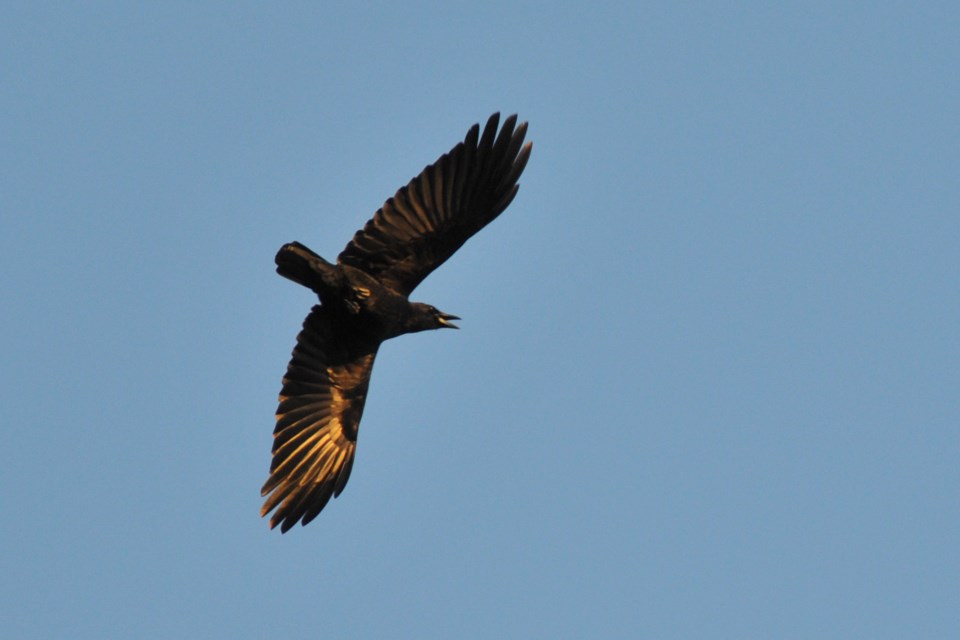A countryside walk will often reveal loose bird feathers. As moulting takes place, the old feathers are shed as new ones grow in. And not wanting to be
flightless, most birds moult one feather at a time, thus always remaining protected from the rain and also retaining the ability to fly.
However, finding a dead bird on a country walk is indeed somewhat unusual, although it happens from time to time. The black lump ahead of us on the meadow trail indicated something unusual was about to be experienced, and the dead crow did not disappoint.
The crow, what was left of it, lay on its back, wings outstretched and tail slightly fanned. The most striking feature, other than the perfect ring of black feathers that encircled the carcass, was the perfectly clean bones.
A surgeon, taxidermist or butcher could have done equal work.
Crows have always been a common part of our valley's life, their raucous cawing acting as an early morning alarm clock for us (I just wish we could get them to start their grandstanding about 45 minutes later!).
Over the past decade the number of resident crows seems to have risen considerably. While once there was a pair, or maybe two pair, which lived their summer months amidst our fields and forest, there are now dozens. And when autumn arrives, their numbers swell into the hundreds. And with our milder, shorter winters of late, they now stay here all year round.
But this dead one is a bit of a puzzle. Other than it was dead, it was a healthy looking specimen, meaning it must have been taken by surprise.
When a great horned owl manages to nab a rabbit or grouse, it may eat it right on the spot but usually flies back into the shelter of the woods. This victim was consumed right out in the open, a brazen act by a very bold predator, not owl-like at all.
The encircling ring of feathers suggested the stalker was a bird of prey, and the clean picked bones further indicated it was a predator quite skilled at obtaining maximum food from its kill. Also, the size of the prey had to be taken into consideration; the competition had to be equal or greater in size. My deduction: a
goshawk had done the deed.
A goshawk is a raptor of impressive size and strength. These large hawks patrol their hunting grounds with steely-eyed efficiency, and are agile enough to take down a mourning dove in full flight. Crows seem to hate them.
Crows will mob a goshawk just as readily as an owl. Mob action is typical of crow behaviour, and it seems to be as well-rooted and often as pointless as human
mob behaviour.
Usually a loud individual incites others to join in on harassing a sleeping owl and soon the woodlot is filled with dozens, even hundreds, of crows all hell-bent on making this one owl's day as miserable as possible.
Now that the dead one's remains are so visible to all who fly by, I'm guessing that all-out war is a possibility. Crows versus raptors. Should be a box office hit.
Okay, I'm being a bit glib about this, but crows just might be capable of diabolical plotting.
Their intelligence has been researched and recorded as being similar to that of a great ape. And this intelligence has perhaps provided for them to escape from the many human-based programs designed to eradicate crows.
Starting in the late 1930s, and continuing to the early 196os, bounties were paid for crows. A person had to present both feet, or an egg, to collect from the government.
In Manitoba a crow collector would be awarded five cents for each pair of feet, and apparently 24,000 crows were turned in (or 48,000 moldering feet, if you do the math).School children were encouraged to destroy crow nests, and in 1939 for each of the 8,103 eggs destroyed, two cents were paid out. Hmm, what an interesting way to encourage children to observe nature.
But as with all bounty programs, it finally became obvious that it wasn't working. The only thing that was being depleted was the government's coffer. “Nevermore” quote the… crow?
And so we'll keep our eyes wide open as we go for our morning walks, as who knows what skullduggery and revenge these black villains are capable of. I think Hitchcock was on to something.



